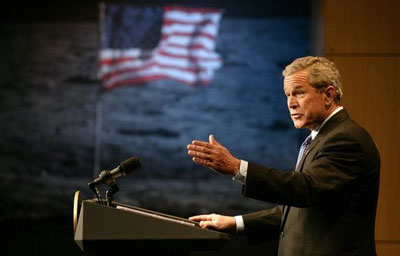Moon-Mars initiative: where do things stand now?by Taylor Dinerman
|
| The surprising resistance to the project inside the US House of Representatives, which is where all Federal spending programs begin, would suggest that NASA will fail to get enough of an increase in its top line budget to start serious work. |
Within limits, these hearings serve two useful and complementary purposes. First of all they keep the Congress and the public informed about the state of the plan and they force NASA to justify itself. This level of transparency is unmatched by any other government on this planet. It’s often painful and embarrassing, as we can see from the results of the Senate probes into the Abu Ghraib abuse scandal, but Americans expect that exposing the government to this questioning will ensure that problems are dealt with openly and directly. It does not always work. Sometimes problems that fail to excite the politicians will go largely unexamined for years, until they blow up in our collective faces. This was true of the S&L scandal in the 1980s and of Islamic terrorism in the 1990s; it was certainly true for the so-called “cultural problems” at NASA before the Columbia disaster.
The second function that these hearing serve is internal, as they force the leaders at NASA (and elsewhere) to articulate clear, logical, and defensible rationales for whatever it is they are trying to do. A project that might be acceptable inside a bureaucratic intra- or inter-agency meeting where everyone’s requirements are met and a messy compromise is arrived at may not be acceptable when the chief of the agency is trying to defend it in front of a committee. Sometimes the demand for information from these committees is excessive, but this can be useful as a way to find out what an agency does or does not know about its own internal situation.
When the Aldridge Commission does deliver its findings the debate will intensify. Frank Sietzen of UPI has reported that Bush plans to give a speech on the subject sometime after the report has been presented. Combined with the ongoing NASA reform effort, the result may be that for the first time since 1960 the election campaign will include a debate on space policy. That would force both Bush and Kerry to explaining their visions for the future to the voters. Thus, whoever is elected would arguably have a mandate for what they want to accomplish.
| For the first time since 1960 the election campaign may include a debate on space policy. That would force both Bush and Kerry to explaining their visions for the future to the voters. |
Meanwhile, the publicity surrounding NASA’s accounting mess just proves the old adage that “no good deed ever goes unpunished.” For years before Sean O’Keefe took over, NASA’s financial management system was an obsolete, disgraceful, mess. The commitment to so called “full-cost accounting” was, at best, being implemented at glacial speed. Now that they are actually doing something about the problem all the old problems are exposed and at the same time the new system is not yet operating as promised. It’s a typical story for our age, those who try to repair a flawed institution not only get blamed for not having an instant, perfect solution, but they get the blame for the institutional dysfunction that created the need for reform in the first place.
America’s need for a strong visionary program that will revive its aerospace industry and inspire and educate the next generation of engineers and scientists is more urgent than ever. The Hart-Rudman Commission, the Walker Commission, and no doubt the Aldridge Commission all tell the political leadership the same thing: we need a better prepared technical workforce for the challenges of the 21st century. The project to go to the Moon and eventually to Mars, if sustained, will provide jobs and training for thousands of bright, hardworking young people, many of whom will go on to create the industries, jobs, and wealth needed for the future.
